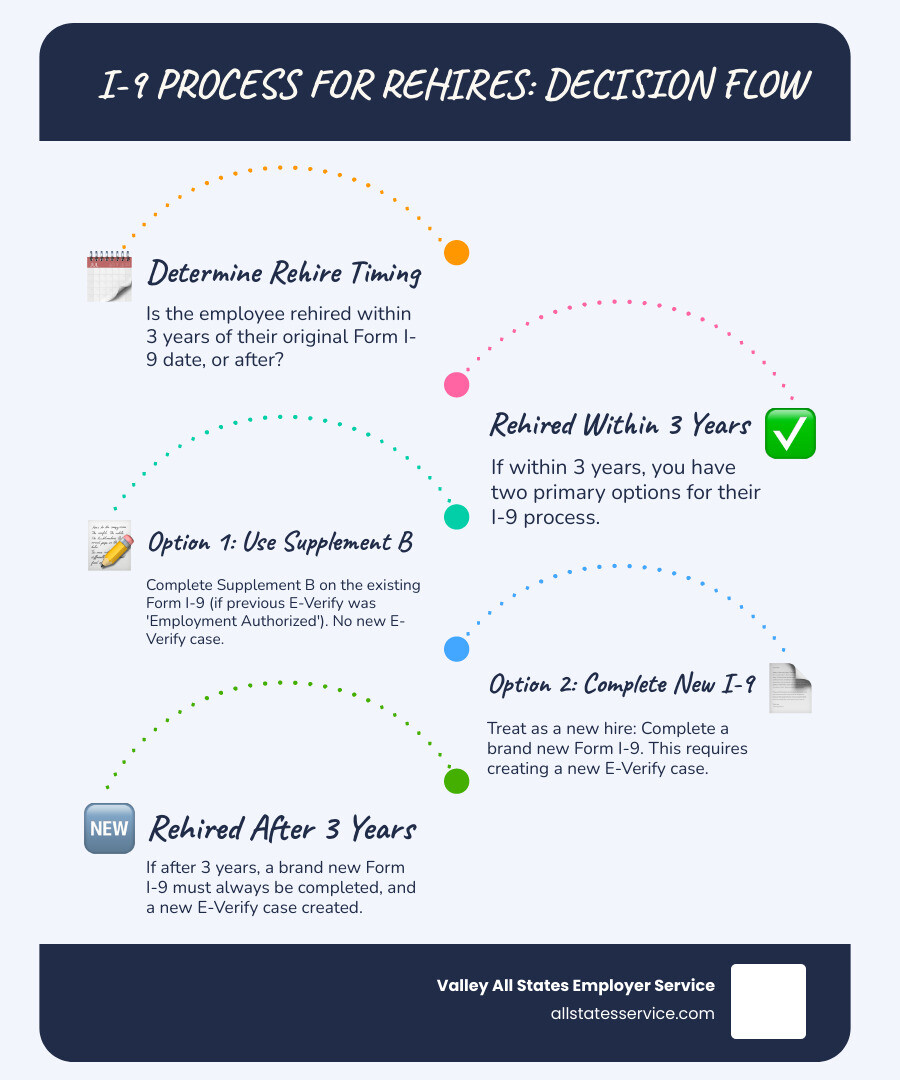I 9 process for rehires: Avoid 3-Year Penalties
Bringing Back a Former Employee? Here’s What You Need to Know
The i 9 process for rehires follows different rules than hiring someone new. When you bring back a former employee, you have two main options: complete a brand new Form I-9 or update their existing one using Supplement B.
Quick Answer for Rehired Employees:
- Within 3 years: Use existing Form I-9 with Supplement B or complete new Form I-9
- After 3 years: Must complete new Form I-9
- E-Verify required: Previous “Employment Authorized” result affects your options
- Expired documents: May need reverification depending on document type
Here’s the reality many HR managers face: you’re juggling dozens of compliance rules, and rehiring seems like it should be simpler than starting from scratch. But the I-9 process for rehires has its own set of requirements that can trip you up if you’re not careful.
The good news? Once you understand the three-year rule and know when to use Supplement B versus a new form, the process becomes much more manageable. You’ll save time, stay compliant, and avoid the costly penalties that come with I-9 mistakes.
The key decision point is timing. Did this employee work for you within the last three years? That single question determines your entire approach and could save you significant paperwork.

The 3-Year Rule: Your First Big Decision Point
Think of the three-year rule as your GPS for navigating the i 9 process for rehires. It’s really that simple: count back three years from today to the date when your returning employee first completed their original Form I-9. That date determines everything.
Here’s where it gets interesting. If you’re rehiring someone within that three-year window, you’ve got choices. You can either dust off their old Form I-9 and update it with Supplement B, or you can start fresh with a brand new form. It’s like choosing between updating your existing recipe or writing a completely new one.
But if more than three years have passed since that original I-9 was signed? The decision is made for you. You must complete a new Form I-9, no exceptions. Think of them as a brand new hire, because that’s exactly how the law sees them.
Now, here’s something that trips up a lot of employers: the retention period. You need to keep completed Form I-9s for either three years after the hire date or one year after employment ended, whichever comes later. This means you should still have that paperwork when your boomerang employee comes back. For all the details on staying organized with this, check out our guide on I-9 Record Keeping.
When to Complete a New Form I-9
Sometimes completing a new Form I-9 isn’t just an option, it’s your only path forward. If you’re rehiring after three years, there’s no wiggle room. That employee gets the full new-hire treatment, complete with fresh paperwork.
But even within that three-year window, you might need to go the new-form route. If you never created an E-Verify case for this employee originally, or if their previous E-Verify case didn’t result in “employment authorized,” you’ll need to start over with a new Form I-9 and create a fresh E-Verify case.
Some employers choose the new-form approach for consistency across all rehires, regardless of timing. While it’s not legally required for every situation, it can simplify your processes and reduce the chance of mistakes. Sometimes the straightforward path is the smart path.
Understanding What is an I-9? helps you see why these rules exist. It’s not just bureaucratic paperwork, it’s about maintaining proper employment eligibility verification throughout an employee’s journey with your company.
When You Can Use the Original Form I-9
Here’s the good news that makes rehiring feel a bit more manageable. If you’re rehiring within three years and their previous E-Verify case showed “employment authorized,” you can often stick with their existing Form I-9.
This is where Supplement B becomes your best friend. Instead of starting from scratch, you simply update the existing form with their rehire information. It’s like adding a new chapter to an existing book rather than writing an entirely new one.
The beauty of this approach is efficiency. Your employee is still work-authorized, their documents haven’t expired in ways that trigger new requirements, and you have a clean E-Verify history with them. Why reinvent the wheel?
This option works particularly well for seasonal employees or those returning from leaves of absence. You’re building on a foundation that’s already solid and compliant. For more insights into how this form works, take a look at What is I-9 Form? to understand all your options.
The Step-by-Step I-9 Process for Rehires Within 3 Years

When a former employee walks back through your doors within three years, you’re in luck. The i 9 process for rehires gives you flexibility that can save both time and paperwork. But here’s the thing: your approach depends entirely on what happened with their E-Verify case the first time around.
Think of it like this: you have two paths in front of you. One is the express lane (using Supplement B), and the other is the standard route (treating them as a new hire). Both are perfectly valid, but knowing which one to choose makes all the difference.
Your decision point is simple: did their previous E-Verify case result in “Employment Authorized”? If yes, you can take the express lane. If not, or if you want to keep things consistent across all rehires, the standard route is your answer. Understanding E-Verify and I-9 integration helps you steer these choices with confidence.
Option 1: Using Supplement B for a Quick Update
This is where the i 9 process for rehires really shines. When you can use Supplement B, you’re essentially updating their existing paperwork rather than starting from scratch. It’s like adding a new chapter to a book instead of writing an entirely new one.
You can use this streamlined approach when you rehire someone within three years and their previous E-Verify case came back as “Employment Authorized.” Here’s what makes this option so appealing: no new E-Verify case required.
Start by pulling out their original Form I-9. You’ll need to confirm this is definitely the same person and check whether they’re still authorized to work. Then comes the straightforward part: completing Supplement B itself.
In the employee’s full name section, enter their name exactly as it appears on the original form. If they’ve gotten married or legally changed their name since then, there’s a handy “New Name” field for that. Next, add the date of rehire in the designated spot. Finally, you’ll sign and date the employer section with your company information.
Now, here’s where document status matters. If their original documents haven’t expired or don’t require reverification (think U.S. passport or List B documents), you’re done. Just write the rehire date and move on. Even if certain documents have expired, like a U.S. passport or Permanent Resident Card, you still don’t need to create a new E-Verify case.
However, if they had expired List A or List C documents that establish work authorization with expiration dates, you’ll need to update Supplement B with their new document information. The good news? You still don’t create a new E-Verify case because their original employment authorization was already confirmed.
For detailed guidance on this process, the USCIS provides comprehensive instructions in their guide on Completing Supplement B, Reverification and Rehires … – USCIS.
Option 2: Treating Them as a New Hire
Sometimes the straightforward approach is the best approach. Even when you could use Supplement B, you always have the option to complete a brand new Form I-9. Many employers actually prefer this route, and here’s why.
Consistency is a beautiful thing in HR. When you treat every rehired employee as a new hire, your team doesn’t have to remember different rules or worry about which path to take. Everyone gets the same treatment, which means fewer mistakes and simpler training.
Compliance simplification is another major benefit. If you’re unsure about E-Verify history or document statuses, starting fresh eliminates any guesswork. You know exactly what you’re getting: a complete, current Form I-9 that follows standard procedures.
When you choose this option, you’re committing to the full process. The employee completes Section 1, you handle Section 2 by examining their documents within three business days, and you must create a new E-Verify case. This last part is crucial: unlike Supplement B, the new hire approach always requires a fresh E-Verify case, regardless of their previous status.
This path involves all the same steps you’d take with any new employee. It’s familiar territory, which can be comforting when you’re dealing with compliance requirements. At Valley All States Employer Service, we specialize in I-9 Form Completion, ensuring every step meets federal standards whether you’re dealing with brand new hires or returning employees.
Handling Document Verification and Expirations

When it comes to document verification in the i 9 process for rehires, we follow the same golden rule as with new employees: the documents must be genuine and relate to the person presenting them. Here’s something important to remember – we can’t tell a rehired employee which specific documents to bring. That choice is entirely theirs from the Lists of Acceptable Documents.
But here’s where things get interesting with rehires. What happens when their old documents have expired? It’s one of the most common questions we get, and honestly, it trips up a lot of HR teams because the answer isn’t always straightforward.
The key is understanding that not all expired documents are created equal. Some require immediate action, while others can stay exactly as they are. Let’s break this down so you never have to guess again.
What to Do When a Rehired Employee’s Documents Have Expired
Picture this: your star employee from two years ago walks back through your doors, ready to rejoin the team. You pull up their old I-9, and you notice their driver’s license expired six months ago. Do you panic? Not necessarily.
List B documents like driver’s licenses and state ID cards only prove identity, not work authorization. When these expire, we simply don’t worry about them for I-9 purposes. Think of it this way – an expired driver’s license still proves who someone is, just like an old yearbook photo. Their identity hasn’t changed.
List A documents are where we need to pay closer attention because they prove both identity and work authorization. But even here, there are different rules. A U.S. Passport or Permanent Resident Card that appears expired? We typically don’t reverify these because they indicate permanent work authorization. U.S. citizens and permanent residents don’t lose their right to work when their documents expire.
However, an Employment Authorization Document (EAD) that’s expired is a different story entirely. These documents have real expiration dates that matter, and when they expire, the person’s work authorization may have expired too. This triggers our reverification requirements.
List C documents like Social Security cards without restrictions don’t expire, but EADs presented as List C documents do. When an employee’s work authorization expires, we need to see fresh documentation.
Here’s a helpful way to remember what doesn’t require reverification: U.S. Passports, Form I-551 (Permanent Resident Cards), and any List B documents. These are your “safe zone” documents that you can rely on even when they appear expired.
A Guide to the I-9 Process for Rehires Needing Reverification
When a rehired employee does need reverification, we handle it through Supplement B on their existing Form I-9. It’s actually more straightforward than it sounds once you get the hang of it.
First, we let the employee know they need to provide updated documentation. We can explain that their work authorization needs verification, but we can’t specify which document they should bring. They get to choose from List A or List C documents.
Once they present their new documents, we examine them just like we would for any employee. We’re looking for documents that appear genuine and relate to the person standing in front of us.
Then comes the paperwork part. In Supplement B, we record several key pieces of information: the rehire date goes in first, followed by the document title of their new paperwork. We also note the document number and expiration date if there is one.
The final step is our signature and the date we completed this process. One thing that makes this easier than a full new I-9 is that we don’t create a new E-Verify case. The original case already confirmed their employment authorization – we’re just updating the documentation.
For companies managing remote employees, this process can feel overwhelming. That’s where our expertise in Remote I-9 Compliance really shines, ensuring every detail is handled correctly even when team members aren’t in the same location.
Frequently Asked Questions about I-9s for Rehires
We get it. Even with the clearest roadmap, the i 9 process for rehires can throw you some curveballs. After helping hundreds of employers steer these waters, we’ve noticed the same questions come up again and again. Let’s tackle the big ones that keep HR managers up at night.
What if the rehired employee has a new legal name?
Life happens, and sometimes that means name changes. Good news: you’re not stuck redoing everything from scratch.
You have two solid options here. The simpler route is updating the “New Name” field in Supplement B on their existing Form I-9. This keeps everything connected to their original record while reflecting their current legal identity. It’s clean, it’s efficient, and it maintains your paper trail.
Your other choice is having them complete a brand new Form I-9 with their updated name. While you’re not legally required to update the I-9 for name changes, keeping accurate records is always smart business. If the name change is so significant that you can’t clearly link it to the original form, starting fresh is your best bet.
Do I have to create a new E-Verify case if I only complete Supplement B?
This question gets to the heart of why the rehire process can actually save you time. The short answer is no, you don’t need a new E-Verify case when you’re only completing Supplement B.
Here’s why this matters: if you rehire someone within three years and their previous E-Verify case came back “Employment Authorized,” that result is still good. Think of it like a stamp of approval that doesn’t expire just because they left and came back.
You only need to create a new E-Verify case if you decide to complete a brand new Form I-9 for the rehire, or if there was never an E-Verify case created before, or if their previous case didn’t result in employment authorization. Otherwise, Supplement B keeps things simple.
What if the employee’s original Form I-9 is an older, outdated version?
Forms evolve, and if your employee’s original I-9 is from a few years back, it might be an older version. Don’t worry about this mismatch.
You’ll need to complete Supplement B on the current version of Form I-9. Always use the most up-to-date form available. Once you’ve filled out the new Supplement B, simply attach it to their original Form I-9. This creates a complete record that spans different form versions while keeping you fully compliant.
This approach ensures all your documentation stays connected and meets current standards, even when dealing with forms from different time periods. It’s one of those situations where mixing old and new actually works perfectly.
Stay Compliant and Avoid Costly Penalties
Getting the i 9 process for rehires right isn’t just about following rules, it’s about protecting your business from expensive mistakes. When you understand the three-year rule and know when to use Supplement B versus a new form, you’re already ahead of most employers who stumble through rehiring without a clear plan.
Consistency is your best friend when it comes to I-9 compliance. Whether you decide to update existing forms with Supplement B or treat every rehire as a brand new employee, the secret sauce is having a clear process and sticking to it every single time. No exceptions, no shortcuts, no “just this once” decisions that come back to haunt you.
The stakes are real here. I-9 Compliance Penalties can range from hundreds to thousands of dollars per form, and those fines add up fast when auditors find patterns of mistakes. We’ve seen businesses get hit with penalties that could have funded their entire HR department for months.
Here’s what we’ve learned after helping countless employers steer rehiring: the complexity isn’t in understanding the rules, it’s in managing E-Verify complexity alongside I-9 requirements while juggling everything else on your plate. That’s exactly why Valley All States Employer Service exists. We take the guesswork out of compliance so you can focus on what actually grows your business.
Think of us as your compliance safety net. We provide expert, impartial, and efficient E-Verify processing that minimizes errors and cuts through the administrative burden that bogs down so many HR teams. When you’re confident your I-9 process is bulletproof, you sleep better at night.
Ready to streamline your hiring compliance? Learn more about our E-Verify and I-9 services and find how much easier rehiring can be when you have the right partner in your corner.
